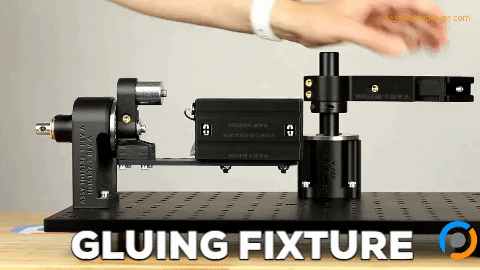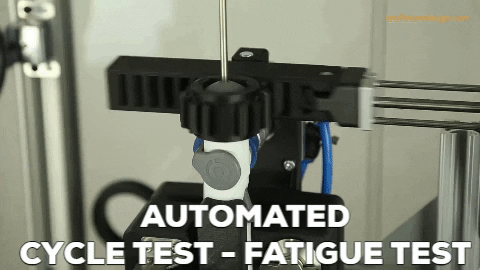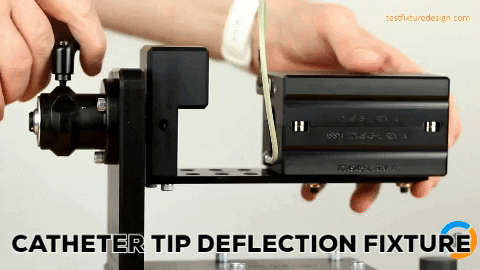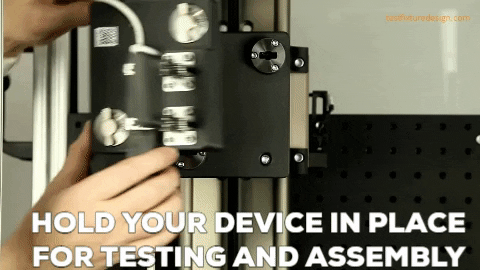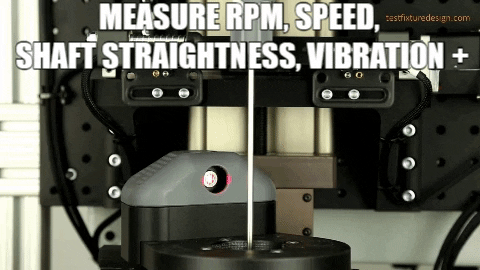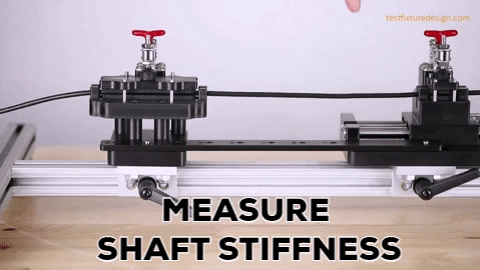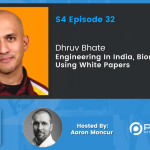S4E29 Drew Devitt | Porous Media Air Bearings
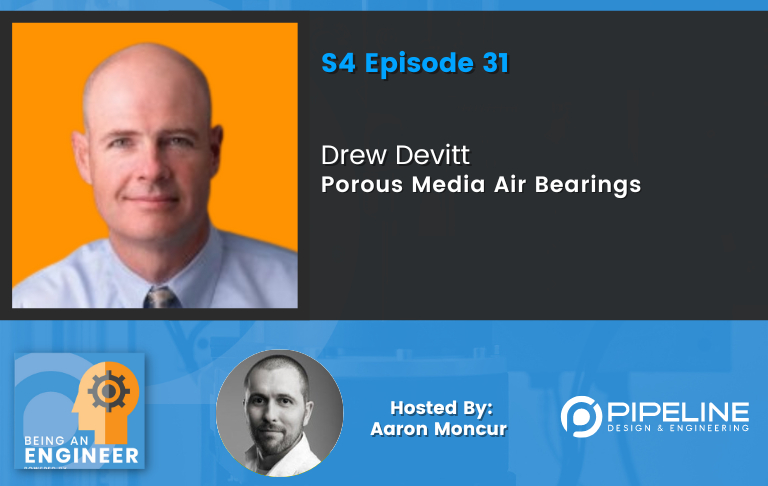
Who is Drew Devitt?
Drew Devitt is founder and CTO at New Way Air Bearings where they manufacture porous media air bearings for high precision friction free motion applications. If you have ever had an application in which you need frictionless motion, this episode is for you. New Way’s porous media air bearings are like magic in their ability to move loads with precision and ease.
https://www.youtube.com/@drewdevitt
Aaron Moncur, host
EXPAND TO VIEW EPISODE TRANSCRIPTION
SUMMARY KEYWORDS
bearings, air, bearing, porous media, engineers, applications, orifice, machines, put, mounts, talking, big, stiffness, graphite, vacuum, surface, floats, flexure, film, friction
SPEAKERS
Drew Devitt, Aaron Moncur
Aaron Moncur 00:04
This fall, we’re launching a brand new platform of tools, education and community to dramatically accelerate the speed of engineering. This platform is specifically built for teams to develop physical goods, such as machines, devices, and consumer products. If you are a mechanical engineer, r&d engineer, process development engineer, mechanical designer, product development engineer, or similar, we think you’ll love what we’re working on. More info to come soon, so keep your eyes and ears open for the full launch of the website. In the meantime, send us a note at podcast at Team pipeline.us. And let us know what features or functionalities you would find most useful in this platform. Hello, and welcome to another episode of The being an engineer Podcast. Today we’re speaking with Drew Devitt who is founder and CTO at new way air bearings where they manufacture porous media air bearings for high precision friction free motion applications. I actually did a article about their product a little while ago, and it was just such a cool product that I was I was thrilled when Drew was willing to come on to the show and talk a little bit more in detail about what are porous media era bearings? How are they used? How are they going to benefit you and in your engineering application? So Drew, thank you so much for being willing to spend some time with me on the show today.
Drew Devitt 01:59
Well, thank you for having me on your podcast. Aaron. glad. I’m glad to be here.
Aaron Moncur 02:04
Can you tell us a little bit about your background? You know, how did you get into manufacturing and and the porous media air bearing technology?
Drew Devitt 02:13
Well, it’s, it’s funny, you should ask that. And I went to your website, and I happen to see how you describe how you got started and some of the frustrations that you had gone through. So I think we have a similar tale to tell and maybe I can weave it together here. So when I started on, basically graduating from college, and all through high school, my parents had a business in the house, where they imported a product from Germany called mogleiss, which is a moldable slideway material. And my dad was selling it to the US machine tool builders. So the people that build big metal cutting machine tools and grinders and mills and planer mills and things like that. Were users of this Mowgli, so he would take me on his business trips, I would get to see these big factories where they were building huge machines and it even just in high school. And then in college, I did, I guess you’d kind of call them internships. But in the summers, you know, he would send me off to a rebuilder in Milwaukee, or in Cleveland or something, I’d spend three or four weeks out there, you know, working with them, and learning how to do machine tool, rebuilding, and especially, I learned to scrape. I don’t know if, I mean, it’s scraping, it sounds kind of rough, but it’s actually a really fine precision art, where you take two pieces of usually cast iron, and you put them together and you’ve got this ultra thin layer of blue on one side, and red LED on the other side. And then you rub the surfaces together, only about you push it maybe a half inch at the most you know, and then you pick it up and you see where the contact was. So you scrape on those surfaces and then stone it off and put it back together again, until you get the whole surface to bear properly. Right? It’s just the way they did it the old days. So so the Mowgli’s was a moldable material. So if you had one surface that was perfect, you could mold the other surface and then you’d have a perfect fit. You wouldn’t have to scrape them to fit. But you would still have to scrape one surface to get it to be right you know, you needed one good surface so so I had to learn how to scrape and then I learned to apply the Mowgli’s material and I wound up going around training rebuilders how to apply this material. Then when I got out of college I was you know trying to get the business big enough to move out of the house right. But I had a I had a paradigm problem, right? So the machine tool builder Here’s not only you know, the 80s, it was a rough, rough decade for them. A lot of them were going out of business. And for me it was rough. Not only were my customers going out of business, but a lot of them were changing over to linear guide systems. trackway systems where you’ve got a guideway that’s hardened steel, you know, and it’s got ball races or cross roller races and you bolted down and it’s got a truck, and you bolt something to it. Right. Well, that was like the death knell for scraping right and plain ways. So, you know, I could see the market for that was tanking. And I better come up with another program if I was going to retire in this business. So So I developed hydrostatic bearings, I thought hydrostatics were the way to go first, because I could still mold them the Mowgli’s I could mold the pockets. And so that wasn’t very successful, though. And, you know, at this point, I was probably already drinking, right. And I’m at the bar with my dad, one of his friends from Oak Ridge National Laboratory. And he, he draws on a napkin like engineers do you know any, so he draws in a couple bearing housings, basically, that he wanted me to make. And then he sent me some of the graphite, you know, to make the graphite wafer to go in there. So basically, he told me how to make these bearings at the bar gave me a napkin slapped me on the backs that make me these bearings, right. So so I did, and it was interestingly, especially milling the graphite, right? So, so in, in high school, I had also gotten a job at a local machine shop, because I was already kind of into machines and metal cutting. So one of my, one of my friends had a father Adam machine shop. So I started working at the machine shop, this was like, probably 19, seven years. So it’s a long time before, right. But the machine shop was interesting, because the dad sort of took me under his wing, you know, and I was working with him in the back. And he was the owner of the business, right. So he was an interesting mentor for me, I learned a lot. I think he was really just trying to spy on his own kids. And he wanted me to tell him what was going on. But anyhow, I had a nice start in a machine shop. So this was actually years before I’d made these bearings for my dad’s friend, and the machining, the graphite without a dust collector was an experience, and I couldn’t even see the part in the handles that, but anyhow, they worked out for him. And then years later, he ordered a couple more, and I found some other people to buy, I’m still you know, 95% in the in the Mowgli’s business. So then he gets a job as Chief Engineer at Sterrett. So stare at a metrology company, they make a lot of micrometers. So they decided they wanted to go into the coordinate measuring machine business. And that’s right near Oak Ridge, and where they were down in North Carolina. So he, he designed seven or eight brand new coordinate measuring machines, and they all use my air bearings. And so that’s where I really had my first OEM for the air bearing business.
Aaron Moncur 08:25
And to be clear, this the graphite that you were talking about that that is the air bearing, right?
Drew Devitt 08:31
Right, So the graphite is it’s the, it’s the restrictive element in the air bearing. So normally, we still use metal. And most bearings, you can make a bearing completely out of graphite, but we use metal because it gives you a higher modulus, you can, you can carry more weight.
Aaron Moncur 08:49
So let’s talk about the physics of the air bearing a little bit. I mean, when people hear air bearings, before I knew about porous media, air bearings, I would think of an upside down air hockey table, right? Like a metal Puck, that blows air out the bottom and creates just a little bit of lift so that whatever your payload is on top feels much less heavy and you can move it around a work surface, but the porous media air bearings they work similar but but different than the I’ll call it the upside down hockey air hockey table. Tell us a little bit about the physics behind how porous media air bearings work.
Drew Devitt 09:30
So all air bearings basically have some sort of a restrictive element. Right? So if you if you didn’t have a tube going to every air bearing, you know the one on the on the bottom that doesn’t have any clearance like all the air we just rush out of that one right. So all the air bearings, if they’re plumbed to a common source need to have a first restrictive element so that you have one becomes completely unloaded all the air just doesn’t come out. So, orifices are one way to do that, right? And but porous media, right? Whether it be a ceramic or graphite or carbon or a bronze or aluminum or granite is actually porous. You do medium is porous, right. So, we’ve made air bearings out of all these things. The key is that it’s wrist restrictive element. And then the second restriction in the air bearing is the gap itself, right? So the air is trying to get out of the gap, right, but the gap is so small, that he can’t get out right away. And there’s constantly new air coming in, even as he gets out the edge. And so that’s what actually carries your load or your weight. And so with air bearings, generally, if you put in, say, 100 psi, you’re going to get maybe 50 psi unit loading underneath of the bearing, put in 60 psi, he’d probably get around 30. What’s interesting, though, is, if you put in 1000 psi, you get closer to like 900 psi, I want you to along. So you really only need that, you know that that first delta of a few bars worth of pressure?
Aaron Moncur 11:23
Yeah. Okay. And with orifice air bearings, typically there’s just one orifice, or maybe they’re two or three or four, but they’re very small few. Whereas with porous media, because of the nature of the material that you’re using, there are, I think, get some of the microscopic orifices for lack of a
Drew Devitt 11:44
million, right? There’s a millions of these little sub micron orifices and and you think well, wow, that would plug up, right. But you know, what’s interesting is, that’s, that’s the reliability problem that orifice bearings have, right, because here, you’ve got this orifice, let’s say it’s a six thousandths diameter hole, or maybe it’s a big one, it’s like 10,000 Trent, well, a doesn’t take much of a particle, plug that up, right. And it’s really hard to keep particles out of a system, you know, something’s gonna slough off the inside of a tube or a little Teflon tape is going to be in there. So you have some now you have that orifice, at some time, and it’s law life, it’s gonna get plugged, right. But with a porous bearing, you could go ahead and pour sand into the bearing, you know, our stuff, Teflon tape in there, you know, you can do just about any kind of contamination you can put in there, you can fill up the whole plenum inside of the bearing with stuff that would plug an orifice bearing, and it won’t have any effect on the pores bearing because it’s got less restriction than the porous media. Right? So it’s not even gonna slow down the flow of air pressure.
Aaron Moncur 12:56
Yeah, yeah. Very cool. Now, what are some of the let’s call them environmental constraints within which one needs to work when using porous media air bearings, for example, the surface flatness of the bearing surface, or the surface underneath the bearing on which is writing things like that?
Drew Devitt 13:20
Right? Well, for sure, that is an important element, you know, and there are different types of air bearings, there are air bearings that are used by riggers there, I refer to them as skirted bearings, right? So they will, you know, allow you to move really heavy machines around on floors that are pretty rough. But, you know, they’ve got a skirt to keep the air pressure underneath, right, we don’t have any skirt or any contact at all. And so we let the air come right out the edge, and we depend on a very small gap. So a flow through a gap for a given pressure is a cube function of the gap. So as the gap keeps getting smaller and smaller, you know, the restriction goes up, in a big way. And so it’s very interesting, and maybe we’ll talk about this a little later. But air bearings can have a big range of stiffness because of the air gap. You know, you can go from having almost no stiffness, having nearly infinite stiffness and a thousandths of an inch.
Aaron Moncur 14:32
Yeah, let’s talk about stiffness. What does that mean, specifically within the context of these air bearings?
Drew Devitt 14:39
Well, your stiffness is it can become a very complicated thing. So I think I like to try to simplify it, right. So if you think about damping, it’s basically you know, a combination of motion and force Right, so how much motion is there? And how much force is there? You know, does it take to have that? And so that would be stiffness, right? Like how if you put a force on there? How much does it actually move? Right? So, if you’re thinking about damping, you can’t have any damping. If there’s zero motion, right? So if you’ve got infinite stiffness, you’ve got zero damping. But if there’s zero force, right, if you push on something, and there’s nothing, you know, then then you’ve got zero damping, right? There’s because you’ve got zero stiffness, again, right? So you got these two opposite spectrums with respect to where you’ve got zero damping, right. And, for a given frequency, there’s going to be some point, you know, so if you, if you increase your stiffness and increase and increase, your damping is going to go up and up and up to some point, you know, and then if you go make it any stiffer than the damping is going to start to go down. And so, you know, that’s a really simple way of thinking, damping, stiffness, and
Aaron Moncur 16:12
damping these forgive me for interrupting these air bearings are often used in in very high precision applications, you mentioned CMM, right? Obviously, metrology, it needs to be really super accurate. And so if you have because the bearings are riding on a film of air, if if it was to be not very stiff, in other words, it could fluctuate up and down on that film of air, then your measurements could be off. So it’s really important that you have this stiffness, and that that’s why that’s the phenomena that we’re talking about. Right right now. And the film of air on which these bearings, bearings, right are typically somewhere around like five microns, something like that, is that right?
Drew Devitt 16:58
That’s correct. That would be sort of a target, where you where you’re going to have really good stiffness and good damping to,
Aaron Moncur 17:05
yeah, okay. And because he have good stiffness, it stays at, you know, around five micron, maybe plus or minus one micron, or something like that. But it’s really stiff, so that your measurements, whatever your application is, doesn’t inherent, the, the, what’s the word I’m looking for? Variable variability that would be inherent with low stiffness.
Drew Devitt 17:31
Right. And, you know, there’s the idea of dynamic stiffness, which, for instance, you know, there’s all kinds of things on a CMM that are moving around, right, and all sorts of sources of vibration. And sometimes, especially when you’ve got like a long arm, and it’s sticking way out, in the last thing you want to do is try to set up some sort of a vibration. Right? So you actually, you want your air bearings to be consistent with thud knot ring. And yeah.
Aaron Moncur 18:04
Let’s talk a little bit about the carbon nature of these porous media bearings. When I first learned about the carbon, I thought to myself, Oh, well shoot, this won’t work for a lot of our applications, because a lot of our customers are medical device customers, and the equipment that we develop a pipeline goes into a clean room, and while carbon flakes off so easily, and so it can’t be used in a clean room. So thus, the this, this technology wouldn’t be a good fit for us. But as I learned, that is not the case. Can you talk a little bit more about why the the carbon material actually does work and is used quite often in cleanroom type settings.
Drew Devitt 18:48
Right. So, you know, the big key there is that the air bearings aren’t touching, right? So they’re not actually, you know, they’re not wearing and so the, the particles aren’t coming off, like, they would be coming off of a rolling element bearing or a plane sliding bushing or something like that. So the big key is just non contact is always a good way to avoid articulation. And so in a lot of those cases, you know, people leave the machines running all the time, like, you know, with our graphy machines, right, those machines run 24 hours a day, you know, 365 days a year, that never gets turned off. And so the bearings don’t touch and they don’t make particles, and we managed to get into some pretty sophisticated machine tools or lithography type machines where you wouldn’t expect to be able to put a piece of graphite like that, but yeah, yeah. So
Aaron Moncur 19:48
how about the different types of bearings that new air bearings offers? The ones that we used were were round, flat airbags earrings, but you offer quite a few different varieties. Can you talk a little bit about the different options available to engineers who might want to incorporate these into their application?
Drew Devitt 20:10
Sure, well, the the puck bearings, both rectangular and round are probably, you know, the most standard broad brush product that we’re selling. You can size them based, you know, just off of the size charts. And as far as the load, but they’re a little different, you know, you’re going to be building a machine along the lines of a metrologist, or semiconductor stage builder, something like that, you know, it’s not bolting down the linear guideways. But, you know, we’re glad to help you with that. And it’s really a lot simpler than you might think. contract may be to your experience, Aaron, but I, I’m glad it all worked out,
Aaron Moncur 20:57
you know, it all worked out the I know, I should say those,
Drew Devitt 21:01
those bearings mount, you know, basically on ball studs. So you just, you know, you just adjust them until you’ve got your stage lined up right where you want it to be. And then here are your preload ones, there’s a couple different ways you can preload them, you can just turn the pressure down to like 30 psi, if let’s say you’re running at 60 psi, turn the pressure down to 30. And just keep keep tightening the preload bearing until it just starts to drag, and then turn your pressure back up to 60. You know, and, you know, that would be a good place to be.
Aaron Moncur 21:36
And the preload that you’re talking about this is what’s referred to as VPL, or vacuum preload bearings. And this is a another type of porous media, air bearings. That includes a vacuum, which seems a little counterintuitive, at least it did to me at first, it seems like the vacuum would counteract the effect of the pressure that you’re using to create the air film on which the bearing floats. Can you talk just for a minute again, about why is it necessary to have this this vacuum, what’s the benefit of doing that doesn’t it just counteract the effect of the pressure that you’re putting in.
Drew Devitt 22:18
So some precision engineers on stage builders, like the idea of not having stack stages, you know, they want to basically use one plane as a reference. And so if you can build a bearing system that can do both x and y on one surface, and not have to be stacked and deal with the problems of a stack stage. You can, you can really chase a nanometer, you know, whereas you couldn’t do it when you were on the stack stages before. So the ability to float on a flat surface is, is great. But you know, unless you have a lot of math, you might not have much stiffness and damping in your air film. So now you’ve got, you know, this, this perfectly flat surface that you’re going around on, but you’re kind of on a water bit. And so if you don’t want to add mass to the system, and you can’t really do magnetic preload, because you’re on granite, you can run vacuum to it, and counter intuitively, we use the high pressure of the air bearing gap to seal the atmosphere from getting to the vacuum. Because the air bearings have such a small flow and the gap is so small, and you’re able to keep a vacuum in there without much draw, because there’s not much air going into the vacuum chamber. And then the the pressure differential basically, you know, as the atmosphere pushes the bearing down on to the granite and gives it more stiffness and damping. And now you can drive your stage around, you know, on your perfect plane and have really good vibration resistance. Yeah, it’s deafness.
Aaron Moncur 24:09
So the vacuum preload effectively just increases the stiffness and thus the the accuracy of your bearing rain
Drew Devitt 24:17
bruh. And so in those cases, you know, you’re actually holding the stage down to right with the or the vacuum. So you don’t want to hold with just having eroded, you want to actually hold the stage down too. So you don’t want to just set it on top of the bearing like you do with a ball stud. So that’s when you might use a flexure if you had your experience with the can you know pivot in more than one direction and allow the bearing to accommodate, you know, machining errors or, and become flat with the guideway?
Aaron Moncur 24:48
Yeah, yep. Well, let me take a very short break here. share with the listeners that Team pipeline.us is where you can learn more about how we help medical device and other product engineering or manufacturing teams develop turnkey equipment, custom fixtures and automated machines to characterize, inspect, assemble, manufacture and perform verification testing on your devices. Today, we have the pleasure of speaking with Drew Devitt, , founder and CTO at new way air bearings. So Drew, you mentioned, a few iterations that I had to go through my T went through when we were getting up to speed with the air bearings. And let me just say that it was it was all spelled out in the very thorough and comprehensive design guide that that you folks put together. And as any good engineer, would, we discarded the instructions altogether, and just tried to do it ourselves. Because with that, hey, we’re engineers. How hard could this be right? And turns out, it’s not hard. But there are some critical pieces of information that would have been very obvious have, we just read the design guide in the first place. And one of the things that you mentioned just a minute ago was the use of these these flexure mounts. And these flexure bows, there are a few different styles. But let maybe I can talk about this for just a minute, because we got to evaluate both. I assumed that these flexure mounts would be pivoting on some type of spherical bearings, some type of ball that would allow it to pivot in all directions. And there is a style like that. But what I didn’t realize was there’s also another style that basically relies on the elastic deformation of a small wall of material in the bearing itself to allow a very small amount of flexure. And if you push those too far, they will break as I learned. But if you have a pretty flat surface to start with, you really don’t need a whole lot of flexion. And so to paint the picture of what we were doing, we had three of these puck air bearings that were mounted to what we thought was a flat plate. But when you get to kind of a microscopic level, of course, the plate, it was not precision ground. And so it wasn’t really flattened. So when you look really, really, really close, it may have looked like like a Pringles potato chip, right, kind of wavy. So instead of mounting the bearings directly to that plate, which is what we did first and did not work. One of your wonderful application engineers suggested that we use these flexure mounts, and as soon as we did that, everything worked great, because the mounts allow those pucks took to pivot just a little bit so that all three are in perfect clarity on top of the flat. In our case, it was a granite surface that that we were using. So for all the listeners out there who want to try using these air bearings, just just know that A, you need to use a really flat surface to start with like a granite block, or maybe glass or ceramic or some kind of precision ground metal. But you also need to make sure that if you’re using multiple flat air bearings, they have to be very, very planar with each other. And the way to do that is to use these flexure mounts. And as soon as you use the flexure mounts it everything works very, very well.
Drew Devitt 28:05
So you know, Erina, I was also talking about some of the other bearings that we make and how they mount can I just try to do a little bit because it bears on what we’re talking about here, right. So there’s the flexure mounts, but we also mount on O rings, so like our bushings, you’ll see just have got O rings around them. And so you can push them into a pillow block, kind of like you would conventional plain bushings. And the compression of the O rings, allows for the bearings to kind of find their home, you know, inside of the pillow blocks. So they might not be perfect, but a little bit of compliance from the O rings. As long as that doesn’t really hurt you in your stiffness budget having an O ring in there. With most most, most people don’t have a problem with that, in fact, bushing stages, when you really look at it, it’s usually the shaft that has got lower stiffness than then even the O ring does. But at any rate, the another way of doing it would be our bonded bearings. So we make a few if you have space constraints, you don’t have a lot of room to be able to put in a ball stud or you can do what we had to fact my first patent the vacuum replication process. The idea was that you take an air bearing and it’s flat and you put vacuum to it instead of pressure. And so you put all the air bearings that you want might be 10 or 12 air bearings, they all get vacuum to the guideway which is perfect. And then you put your stage on top of it and you line it up and then you inject the Mowgli so of course right the replication material I was talking about and so that And that cures and now you basically have no clearance in the system. And so now you put the pressure to it, and it floats back and forth perfectly because the bearings are fit.
Aaron Moncur 30:11
Interesting. Does that infer that you need to have a precision ground plate on which you’re adhering those bearings?
Drew Devitt 30:18
No, that’s one of the big advantages, you know, you really don’t have to the whatever you’re bonding it to doesn’t have to be perfect, right? You just wanted the surface to be rough. So the glue sticks to it? Well, an inch is a Mowgli’s right. So that allows you to get all 12 Of those, you’d have to do a very expensive match grinding process to try to get anything that is as close as you can do with the the sucking the bearing on there and squirting the Mowgli’s and
Aaron Moncur 30:47
interesting that an application that engineers can do themselves with some sort of kit they purchase from you, or is that something that your team would do internally and then send out to a customer, it is
Drew Devitt 30:59
that you can do that. In fact, you know, the other customers too, like for instance, with the bushings. They’re designed so that if you build the stage up, and you don’t want to have the compliance of the O ring, we’ve got holes set up in the pillow block. So when it’s floating, just the way you like it on the O rings, you can inject the Mowgli’s in and it goes between the O rings and comes back out the other side. So you get basically locking the bushing in place, once it found the home that it already wanted to live in the air pressure on. So, so you can basically see air bearings in position using an epoxy or a replication material, you want to be careful that you use an epoxy that has got a low shrinkage. While a lot of epoxy, especially if they’re quick curing, you know won’t work though, there’ll be too much shrinkage in it for you.
Aaron Moncur 31:57
That’s really good to know, I don’t think I realized that because the the fracture mounts that we’re talking about, they’re, you know, an inch or two tall, and so they can eat up some height if you’re trying to work in a low profile application. So it’s really good to know that there is another option for mounting these, that doesn’t increase your overall the height of your application, whatever that might be. Okay with
Drew Devitt 32:23
that, right? So you can get your bearings, you know, it can all be in less than half an inch of
Aaron Moncur 32:28
thickness. They’re wonderful, wonderful. All right, New Wave describes their bearings as creating frictionless motion. And can you give listeners a sense of just how true that is? By by talking about what what is the coefficient of friction in these porous media air bearings?
Drew Devitt 32:50
Right. So coefficient of friction is basically how, how hard you have to push something to get it to move, you know, and so, clean sliding bearings, if the coefficient of friction is generally about point one. So if it weighed 100 pounds, you mean you got to push all weighed 10 pounds to get it to slide, right
Aaron Moncur 33:11
and plane sliding bearings, are you referring to like a ball bearing carriage that would slide on a rail, something like that?
Drew Devitt 33:19
No. Plain sliding bearings would be like a bronze bearing or brass spot bearing or a Mowgli’s bearing or a P FET. In Flon tight bearing, right? It’s very real on material material on material, just plain materials. Usually that’s a lubricated surface do right? So that’s the kind of friction where you’re going to have you know about point one, right? Yeah,
Aaron Moncur 33:47
generally feels pretty good, right? I mean, point one coefficient, coefficient of friction, that’s, that’s pretty smooth.
Drew Devitt 33:54
Right? That would be for a plane bearings. I’m kind of I’m talking about bearings here, you know. And so that would be about the coefficient of friction of a of a plane bearing, then you go to a rolling bearing, right? And that’s about two orders of magnitude, right? So we’re talking about, like, 100 times less friction than that. So you’re now point 001, right? For the friction that you would see in a rolling bearing, you know, and that’s, you know, at zero velocity basically. So that friction will go up as your speeds go up. But, and then, when you get to fluid film bearings, where you’re, you know, you’re floating on a film of air or water, right, you’re, you go another two orders of magnitude, basically, or another 100 times, right, so now you’ve got four zeros, you know, after the dot and before the one, right, so it’s not, it’s not zero friction. You’re right. But when, if you think about some of the ESG applications that air bearings could go into right Like look at a converting line, right? Or a newspaper printing line, right? Where you might have 100 rollers in this thing, if they’re all different sizes, right? they’ve each got a motor and an encoder on them, right? And you’re trying to get them all going at the same surface fee, right? And the motors really are not putting work into the film, right? In our into the paper, right? Almost all of the work is just in keeping the rollers turning. Right, yeah. Right. And you think about the energy and all the motors are using, and if they were on air bearings, right, so now the motor really is only working to get the roller up to speed. Right. And at this point, it would spin there like all day at that speed, right? So now it’s not having to put work or energy into it, right? So you could save 95% of the energy of a big converting line or printing one, you know, with these bearings, right? And then there’s other applications to where there’s so much of the power is being used in the process, right, like, say, a 35 megawatt Mark, let’s say 50, because it’ll make it a 50 megawatt compressor, right? It’s, it’s pumping natural gas and compressing natural gas. So you know, it’s probably got two or 3% loss in shear, right? But that means like, 95%, or 97% of the energy is going into compressing the gas. Right. So it’s very efficient that way. Right. But then you think, Okay, well, a 50 megawatt machine 3% of that, right. Like, that’s, like a megawatt and a half. Right? Or, I mean, it’s, it’s a lot, right. It’s a lot of power. Right? And you think, Okay, well, if we can save that power, I mean, that’s still a huge savings, right? Because the heat, just, I mean, they were using probably 850 horsepower, just to cool the oil. Right? Yeah. Right. And so now you don’t have to do that anymore. So you so there’s big savings that are available, because of the frictionless nature. And so for us, you know, we think that we can really take the friction out of the world, you know, and hopefully lubricate things and make things a lot more sustainable with our technology.
Aaron Moncur 37:27
Well, speaking of a compressor, let’s, let’s say that I am an engineer looking into air bearing technology for my application. And I think to myself, Wow, millions of sub micron orifices, through which all this this air needs to flow, I’m going to need to generate a lot of of, of compressed air to use these things. I don’t know, if I have enough compressed air, are we going to have to put in a new system of compressed air, additional shop air? What kind of flow rates are typically required? And are they really high? Or are they you know, pretty manageable, something that you could take care of, even with, like, you know, Home Depot, air compressor?
Drew Devitt 38:14
Right? Well, it depends how many you’re running. But it’s surprising how low the air flow is. So, you know, we can go in and do demos with pretty big equipment, using keyboard cleaner, you know, as our, as our compressed air supply. And now, so amazing. Sometimes we do it at the tradeshow, you know, and we’ll have, we might use, you know, on a full day, if we go through to keyboard cleaners, you know, it’s a lot. For a pretty big demo that’s there, you know, and people are just oh my god, I can’t believe it. And you know, even when you’ve got a bearing that’s plugged into 100 psi of air pressure, if you put it up to your cheek, you can still barely feel the air coming out. It’s not like you know, there’s any kind of jets are and, and because of the porosity, that’s another thing, you know, an orifice, we would definitely feel a stream of air shooting out, right? But porous bearing can have the same flow as an amorphous bearing and you don’t even notice the air coming out of it unless you put it under water to look at the bubbles or something. Yeah. And many the gaps are so small, right? And because of that cube function that I mentioned, the, those small gaps are really effective at keeping that the flows low.
Aaron Moncur 39:33
We had we had a couple of different round flap bearings, but the smaller of the two sets that we used were 25 millimeter diameter, and we had three of those supporting our payload. And we had about 50 pounds of mass that were was being moved around and it was you know, effortless to move 50 pounds with three basically one inch diameter air bearings on The bottom what and so these were the small, I think these were actually the smallest size of the round flat air bearings. And they get much larger than that what kind of masses can be supported, you know, up to how many pounds of mass can be supported with these?
Drew Devitt 40:17
Well, it’s really just an issue of pressure times area. So, you know, we’re, we’re developing air bearings, where we can put over 1000 PSI of pressure to them. So that gives us an opportunity to get 900 150 psi of unit loading, which is about as high as you can get for the tilting pad oil bearings that are on most steam turbans, and, you know, big gas turbines and compressors, like we were talking about, you know, those are all tilting pad oil bearings. So they’re fluid film bearings. But they’re hydrodynamics. So it’s because of the motion of the shaft inside of the bearings that pulls the oil in there. And so they can get up to about 900 psi unit loading with those bearings. And so we’re rivaling them with our gas bearings.
Aaron Moncur 41:13
Yeah. And especially well, I guess, regardless of what type of bearings you’re using, you can always add more bearings to increase that surface area, which effectively increases the payload, right?
Drew Devitt 41:26
Well, you know, you have to be careful there, right? Because as a precision engineer, you have you don’t want to over constraints on lingering. So like, for instance, the stage that you built had three bearings because it was kinematic. Right. So it’s like a Yeah, a three legged barstool. Right. So, you know, if, if you put it down, it doesn’t matter if the surface is in flat in, it will always create some sort of a plane goes three points to find that point. Yeah, you try to put a force bearing in there, and you can you can have trouble with over constraint, you know, or basically typing back and forth on two of them are, yeah, so it’s but okay, you’re, you’re right, sometimes we use five bear, right? And so there’s other ways, sometimes you they might be spring loaded. So imagine you’ve got a ball, right? You put you, you’ve got five bearings, and you put all five bearings, but between the between the bearing and the ball, you’ve got a Belleville washer that’s in they all have the same spring, right? Yeah. And so now, you know, you can now you can carry load on all those bearings. But it’s not going to have maybe the same stiffness that you’re looking for. But God, a lot of cases, you don’t want it to be as stiff as the hard mounted bearings are, anyhow.
Aaron Moncur 42:54
Yeah. So there’s really a lot of versatility at the end of the day here.
Drew Devitt 42:59
Right? So a lot of different ways to mount the bearings for sure. About the
Aaron Moncur 43:04
the lifespan of these air bearings, how long can they last, it probably depends to some extent on the environment, how they’re being run, but it’s a kind of a general rule of thumb to follow.
Drew Devitt 43:17
The problem with being an air bearing manufacturers, there’s really not a good replacement parts business, in most bearing manufacturers get a replacement part business, you know, we really don’t have much of that some of the older CMM ‘s when they come down, they’ll replace the air bearings, but just because they’re rebuilding them, so they put new ones in, but there’s really nothing wrong with them. Now, you could tune them up a little, and they would probably keep working for another 20 years. The you know, it’s when you go and you look at some of these big CMMS at big manufacturers. Right. And, and they’re, let’s say they’re a turbine builder, right. And they’ve got a big coordinate measuring machine right there, you know, like, I can go over there and, and show him well, what like, look at this filter and dryer, right? I don’t think that’s been changed in a decade. Right? And, and, in fact, oh, it looks like it probably came with the machine new, right. And that machines still run it right. And it’s not, it’s not having any problems. And they’re not, they don’t see it as a maintenance issue, even to change the filters for the airline. So, so we don’t have a lot of problems, you know, from air contamination into the air bearings. And we, we don’t have a lot of problems from the bearings wearing out because they’re not touching and, and even. They’re really good in some applications that you might find, like, for instance, in powder applications. You know, graphite is a material that’s approved for FDA applications. And when you have an air bearing that that doesn’t require any oil, that’s a big advantage and FDA applications and then when you’ve got a bearing that’s really A co2, right because it’s got high pressure coming out of it all around the edge. So, you know, if it has to run through a powder and powder environment, it just kind of blows the powder out of its way and leaves this beautifully clear track there.
Aaron Moncur 45:14
Yeah, yeah. So the fact that there’s no contact is really a big deal when it comes to longevity of these devices.
Drew Devitt 45:22
Right. And you know that there’s no oil, because oil is really sort of a sticky wicket that can collects all the stuff that wears the bearing out and provides the lubrication. But you know, it’s basically the lapping slurry. That’s the ultimate death of the bearing.
Aaron Moncur 45:41
Yeah, yeah. pulls in all the particulate come around it and keeps it in there. Yeah. All right. Well, Drew, this has been super informative. I love the technology, it was honestly kind of like magic. Once we got it up and running. I mean, you just nudge it with your finger, this thing floats effortlessly across across the surface, really cool stuff. Anything else that we haven’t touched on that, that you think engineers should know, when considering porous media air bearings for their applications?
Drew Devitt 46:12
Well, I think one of our least exploited technologies is our the radial air bearings. So basically, we’ll take our rectangular size, standard line, and instead of just putting a flat surface on that bearing, we’ll put a radius on it. And so we’ll cut that radius by the length or by the width will cut a concave or convex, right, so you can run films over it without touching it right, you can, you know, obviously, support relatively large rotors, right? Easily, because now you don’t have to have a big slewing ring bearing, right. And they match really well with linear motors that are curved. So there’s a lot of linear motors coming out nowadays that aren’t linear, you know, they’re meant actually, for perimeter driving rotating equipment, like, like a baggage scanner, or a CT scanner, right, where you’ve got a big hole in the middle, you want to be able to support the road or at the perimeter. So that I think is, is a huge potential, because when engineers start thinking about, well, I don’t have to have a shaft in the middle anymore. It’s just so freeing. And it’s, it’s so convenient to build up big rotary systems on just three bearings, you know, radial bearings, and six axial bearings, basically, that are squeezing at three points, right? So you can constrain your axis of rotation and your point axially, you know, just with nine bearings, and that are a really small percentage of the total circumference.
Aaron Moncur 48:00
Yeah, amazing. So many applications that this could be used in.
Drew Devitt 48:04
Right. And, of course, I mentioned turbo equipment. So we’re very interested in high speed rotating equipment. So the air bearings are very good for that. And then we’ve got a lot of IP and experience in floating flat panel glass. So basically making display glass by using the vacuum and the pressure technologies that we were talking about. And then that has led us to the flexible electronics industry. So you’re going to see a lot more of printing electronics on flexible substrates for like solar panels that go on Windows and wallpaper that like is the LED light, like the wall was actually the light, flexible electronics that will be on people’s clothing. And that’s starting to become pretty big too. So as a fashion statement. So there’s lots and lots of potential applications for flexible electronics, not just in displays. But you know, the ability to have an air turn is what we call it so it’s basically an inside out air bushing so that the substrate can float over this roller that doesn’t turn right because it doesn’t touch so it doesn’t have to turn and so because the substrate doesn’t touch, it means you can build up a functional electronics like photo spacers and things on it and not ruin them by running it against a roller right so now you can touch both sides of the film. And then if you squeeze the film between two air bearings, you know now you’ve got it in a really safe place. If you if you were to just like they do with the flat panel glass, you know they they squirt cleaning solution on it and they scrub it and then they blow air on it but If you tried to do that with a flexible substrate, I mean, it’s gonna flap like a flag in the wind. But if you put it between two air bearings, then you can have high pressure grooves and low pressure grooves and get these really high speed air films that a good convective film coefficient to change the temperature, the sound, clean the film, the dry the film, then we can even pass the film through really deep molecular vacuum for coatings. So because a lot of the electronics industry requires vacuum deposition processes, we can even get the song in and out of vacuum chambers, using the air bearing seal just like that vacuum pre loaded bearing that you saw, you know how we were controlling the vacuum with the air bearing. So we can do that even down to molecular slump. Fascinating. So, Danielle, thanks. Let me get some of that out.
Aaron Moncur 50:56
Absolutely. Yeah. Yeah. Well Drew, how can people learn more about new way and the products that you offer?
Drew Devitt 51:04
Well, the new way website is probably the best place to go. If you type in air bearings on your browser, probably new way is going to be the first natural search. So we’re probably not buying the first spot, but when you go down will be the first natural search. So the websites a great place to go. I have a lot of videos up on YouTube, you can find that for true.debit@youtube.com. And my email would be Ddevitt@newwayairbearings.com. Great.
Aaron Moncur 51:46
Well, we’ll list all of those in the show notes as well. So it’s easy for all of you to click through and find all this information. Drew, thank you again, so much. What a insightful and informative conversation this has been. Thank you for spending some time and sharing this technology with all the engineers listening.
Drew Devitt 52:03
Well thanks for your great questions, and the opportunity to answer them.
Aaron Moncur 52:11
I’m Aaron Moncur, founder of pipeline design and engineering. If you liked what you heard today, please share the episode. To learn how your team can leverage our team’s expertise developing turnkey equipment, custom fixtures and automated machines and with product design, visit us at Team pipeline.us. Thanks for listening.
About Being An Engineer
The Being An Engineer podcast is a repository for industry knowledge and a tool through which engineers learn about and connect with relevant companies, technologies, people resources, and opportunities. We feature successful mechanical engineers and interview engineers who are passionate about their work and who made a great impact on the engineering community.
The Being An Engineer podcast is brought to you by Pipeline Design & Engineering. Pipeline partners with medical & other device engineering teams who need turnkey equipment such as cycle test machines, custom test fixtures, automation equipment, assembly jigs, inspection stations and more. You can find us on the web at www.teampipeline.us





